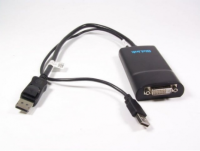dt1 wrote: Higher color depth?

Has a colleague read the specification of both standards?

Yes, buddy, he read the specification and it shows that DVI has a color space only RGB and HDMI also YCbCr 4: 4: 4.
dt1 wrote: (it's strange that the author did not look into it - although who would want to rummage in this unnecessary waste paper)

If the author had looked, he would not have asked the question ... ;-)
dt1 wrote: No additional drivers are required for 144Hz support, system PnP is sufficient.
We know the theory, but in practice we are dealing with Winzgroza 10!
Yes, I am not saying that there is a problem here, but it is worth telling a colleague where to look for problems, or - this is the case - simply raise the topic without an answer.
dt1 wrote:
Three-digit cables are not needed, an honest dual link cable should theoretically be enough.
And with these "cables" it is a great lottery. I've already tested a few and the seller's theories are only half the same as the pest's practice. You are right that you can try - which I didn't think of.
Added after 3 [minutes]: dt1 wrote: Higher color depth?

Has a colleague read the specification of both standards?

Yes, buddy, he read the specification and it shows that DVI has a color space only RGB and HDMI also YCbCr 4: 4: 4.
dt1 wrote: (it's strange that the author did not look into it - although who would want to rummage in this unnecessary waste paper)

If the author had looked, he would not have asked the question ... ;-)
dt1 wrote: No additional drivers are required for 144Hz support, system PnP is sufficient.
We know the theory, but in practice we are dealing with Winzgroza 10!
Yes, I am not saying that there is a problem here, but it is worth telling a colleague where to look for problems, or - this is the case - simply raise the topic without an answer.
dt1 wrote:
Three-digit cables are not needed, an honest dual link cable should theoretically be enough.
And with these "cables" it is a great lottery. I've already tested a few and the seller's theories are only half the same as the pest's practice. You are right that you can try - which I didn't think of. Having my experience, I would not try to look for an adapter with the FHD * 144Hz declaration. It's cheaper than replacing the monitor.



 and 144Hz can only be achieved by connecting DVI-D at both ends.
and 144Hz can only be achieved by connecting DVI-D at both ends.
 , I kept looking and it turned out that the monitor drivers were missing, after installing the problem disappeared and maybe this entry will help someone :spoko:
, I kept looking and it turned out that the monitor drivers were missing, after installing the problem disappeared and maybe this entry will help someone :spoko: